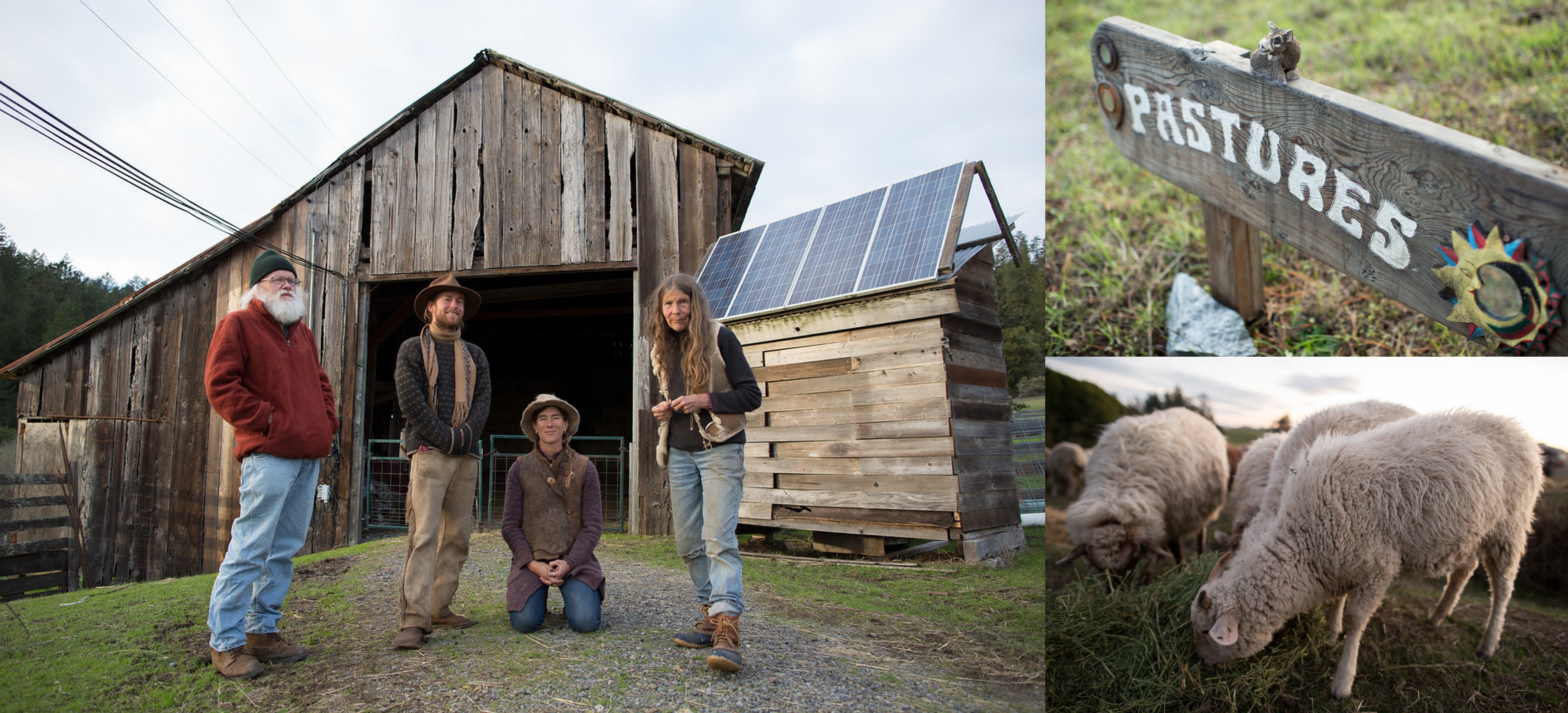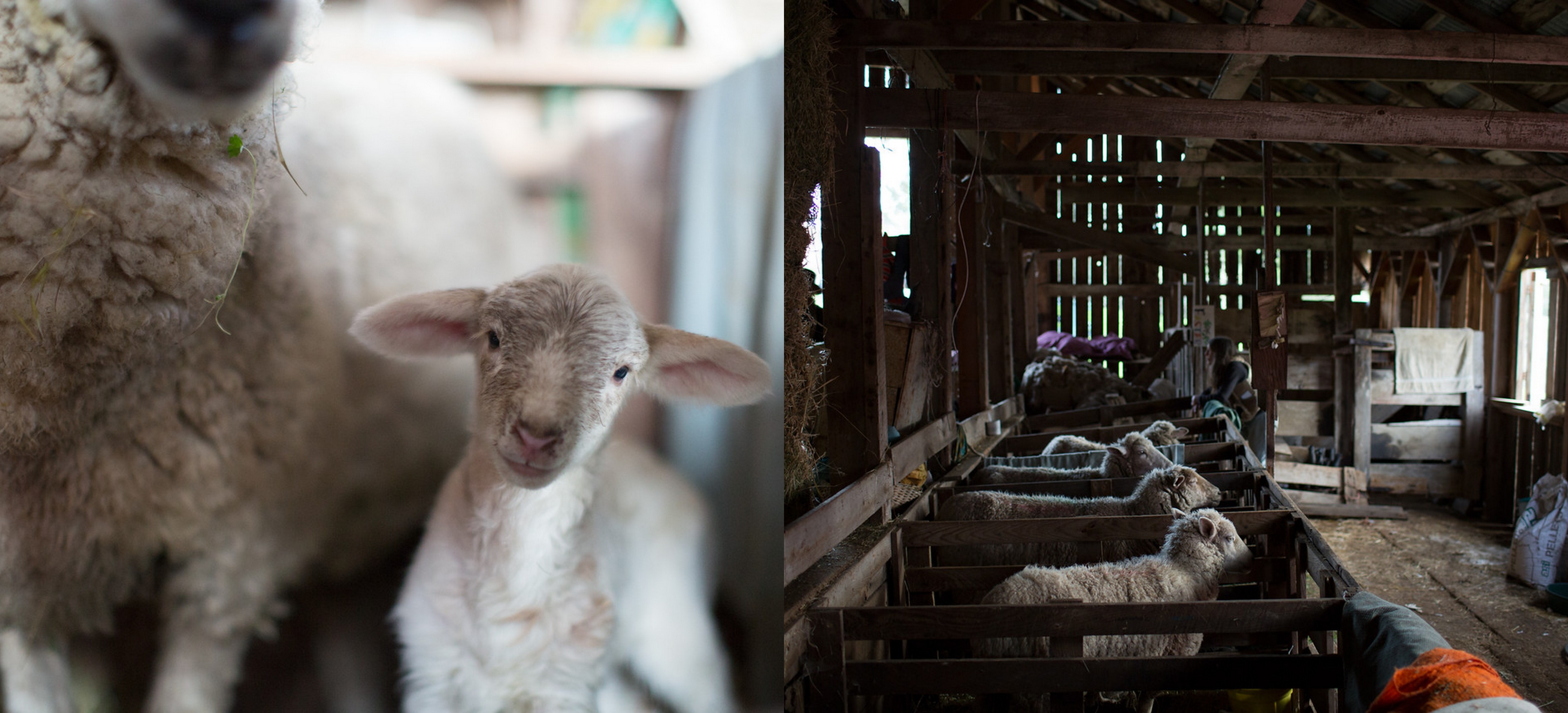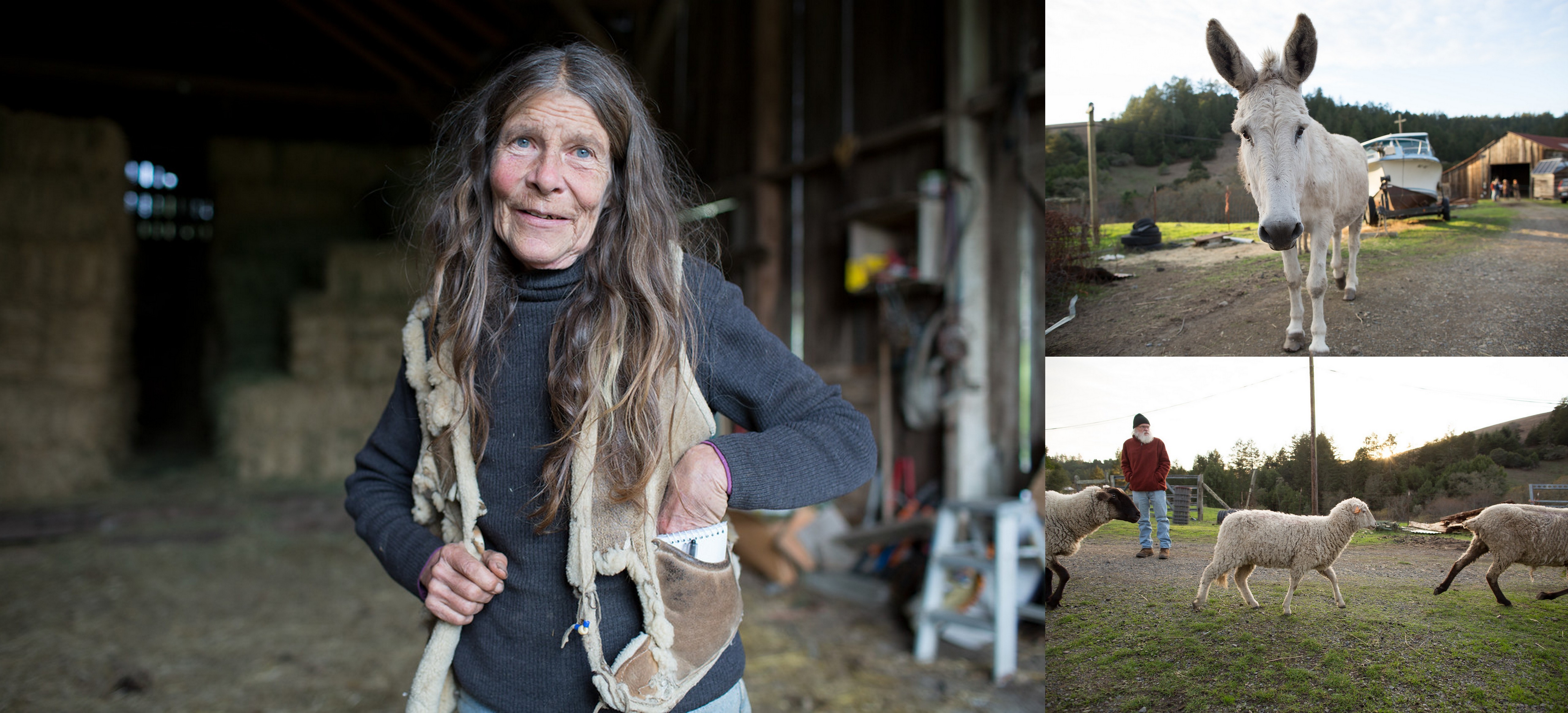Story by Erin Rae, photography by Paige Green.
Let the counting begin. It is lambing season at Bodega Pastures ranch and we are headed out to the pastoral landscapes of ‘west county’ Sonoma to meet the shepherds, their flock, and the new lambs that call this ranch home. This is the season of eager expectation, every early morning has the potential and almost promise of at least one new lamb, but more often three or four, and in the evenings there is frequently the happy surprise of a ewe standing guard over her new offspring. On a sheep ranch this is the peak of the year, when so much new life comes rushing into the world.
A whimsical sign marks our entry into the world of Bodega Pastures and hints at the practical joy that permeates this ranch. The driveway takes you into the belly of the ranch, past a pre-school, an assortment of animals, brief grass filled pastures, sweeping hillsides chaperoned by forests, and over and along moments of the local watershed. We gather outside the aging redwood barn, made majestic by a luminous blue sky, to meet Hazel, Joe, Jay, and Nastasha. These four make up the core of the shepherd team, and their group dynamic is refreshingly unpolished and unrehearsed. They are willing to search around for answers together while we observe, bouncing ideas off one another as they address our questions. Each of them has their own approach to life as a land steward, their own questions to sort out as they move through the landscape, and their own unique observations that they bring to the group, but, as Nastasha points out, the sheep and the land provide the meeting ground where they come together both intellectually and physically.
This common ground they steward is 1100 acres of pastures and forests folded into the hills that lie just east of the Sonoma coast. The ranch is a constantly evolving experiment in stewardship and consensus decision making amongst a loosely connected association of people. It has been on this journey since the late 60’s, a product of that awakening that led many people to explore the nooks and crannies of the Sonoma countryside. Currently they care for about 130 sheep, a few guard dogs, a llama, and about eight miles of fencing.
Today the team is just the other side of the first of the lambing flushes; two dozen in the last two days, and they are eager to check in on a few of their wards. Inside the protection of the barn, amongst an ironic stuffed-animal coyote, and a pyramid of hay bales, are five moms and their lambs in individual pens. These are the ewes and lambs that needed an extra hand in their first days of life together, maybe there were triplets born to an inexperienced mother, maybe the lamb got a little too cold in the first hours of life, whatever the reason, they will shelter here under watchful eyes until they are ready to rejoin the flock. Thanks to the magenta sheets cum curtains, the light entering the barn has a rosy glow that infuses this impromptu nursery with a protective aura and reminds us that, while exciting, this is also a delicate time for a ranch in love with sheep. The ewes are at their most vulnerable and the lambs are, well, lambs.
As if to underscore this vulnerability we turn to the topic of predation, the shadowy antagonist to lambing season. Joe, who has been a part of the ranch since the early days, notes that over the past few years the rate of predation, primarily by coyotes, but also bob cats, mountain lions, and even dogs, has greatly increased. There are a number of causes for this uptick, and the team continues to tweak their systems and test new technologies in their efforts to manage for the benefit of both the domestic animals and the wild ones. Thus far their primary safeguard is electric fencing, though they employ everything from livestock guardian dogs to a flashing light system originally created to help deter (and therefor save) snow leopards from taking livestock; and yet, at least at this point, the predators continue to strike the flock more frequently. Joe explains this new paradigm of loss with patience and respect. In detail he outlines population shifts and the roles of mesopredators in this ecosystem, drawing on his careful observations to appreciate both the fluidity of natural systems and to notice what persists. The animals and the landscape humble him, and remind him that, thankfully, he is not in charge.
A chalkboard nearby describes the feeding schedule for the alfalfa and hay bales that are stacked up so impressively before us. While the sheep spend all year on pasture, grazing roughly 300 of the total 1100 acres (most of the rest is heavily forested), the ranch supplements with both alfalfa and grass hay in the latter months of fall and early winter. During this time there is not as much food in the pasture and the pregnant ewes, heavy with the impending lambs, need the additional nutrition that the hay provides. As we consider these bales and the feeding routine, the team slips into an easy and ongoing exchange about how to continue evolving the ranch towards self-sufficiency, and away from reliance on off-farm inputs (ie. alfalfa). Citing both environmental and economic concerns, especially during the drought when both the demand for and price of hay increases, they feel compelled to explore new approaches to livestock and land management in order to create a more resilient agricultural operation.
Rather than focusing on the limitations that are inherent with self-sufficiency, they greet this transition as an opportunity for innovation, and in doing so, they build a future for Bodega Pastures that is full of potential. They are quickly engrossed in the possibilities of different pasture management techniques, shifting lambing times, and improving soil health. Jay and Nastasha describe herding the sheep through the oak groves in the fall. Carrying long sticks, they knock more of the acorns free and the obliging sheep feast on the nutrient dense nuts. They sprout organic barley for the animals and they grow 18 acres of their own grass hay in anticipation of the leaner months of forage. All of these and many other adjustments bring them closer to their vision of sustainability.
Nastasha’s deep, broad smile only widens as she talks about the options they are exploring. She blends her experiences in organic agriculture and her knowledge of ancestral technologies to broaden the scope of those options. In the breadth of a few sentences she vets a number of new ideas she has been lately mulling over such as coppicing trees and shrubs with the sheep, and whether or not the highly tannic acorns will act as natural wormers. These daily puzzles of animal husbandry nourish her inventive spirit and her connection to the many land stewards that have grappled with similar questions.
Through the volley of question and answer one realizes that this troupe of shepherds has an informal ringleader in Hazel Flett. A transplant from England, Hazel learned to knit when she was 6 and never shook the siren song of fiber arts thereafter. It was a natural jump for her to make to working with the actual sheep when she landed at Bodega Pastures. Together with Joe, Jay, Nastasha, Alyssum, Cathy, Peter, Abby, Tess, Matt, and a number of children living on the ranch, Hazel is carrying on with the work that she began some 30 plus years ago. She has a personal link to each animal, instead of the sheep as a flock, they are individuals to her, and her small, spritely form is somehow the flock made incarnate. Their births into the flock are marked in both her mental catalogue and in a simple notebook that has clearly seen the breadth of the ranch through the back pocket of her daily walks. She calls out their tag numbers based on the faces that she works hard to memorize, and their personal failures or triumphs, be they in mothering, shearing, beautiful fleeces, etc., are individually noted and become part of the conversation as she works with them.
The flock is a mix of a number of breeds: Corriedale, Romney, Suffolk, Navajo Churro, Border Leicester, and Wensleydale. Hazel and Jay explain that they have been working to create a flock of dual purpose (meat and fiber) animals and to “breed for resilience” — or to breed for good mothering instincts — for the ability to thrive on marginal forage and in variable climatic conditions, and a general tendency towards highly healthy individuals. On average they produce about 800-1000 pounds of fiber per year, and the fibers run the gamut from coarse to medium-fine. The diversity of the flock, and therefore the fleeces that are harvested, allows them to select a fleece that will best suit the end product they have in mind, and to offer a range of fleece options to their customers. The ranch sells yarns, batts, fleeces, carded wool, pillows, comforters, and skins.
On this quick winter day, it is soon time for the evening chores. Jay leads us up a steep, grassy slope to help drive the sheep in to the protection of an electric fence enclosure for the night. He grew up on the ranch, and first started working with the sheep when he was 12 years old. We discuss management techniques, interpersonal communication, and his deep sense of responsibility to this landscape and the surrounding ecosystems. When we stop to look back over the breadth of the ranch, Jay obligingly narrates a larger tour of the property, fondly depicting some of the special hidden spots and how the sheep have positively impacted the landscape over the years. His words are infused with gratitude as he contemplates his freedom to observe and experience this landscape on a daily basis.
Cresting the hill, we spot a Navajo Churro ewe that has just given birth. She and the lamb stand framed by sky, a manifestation of breeding for resilience for the world below. For a moment we stop to consider this new link to the ancestry of shepherds that have cared for this heritage breed over so many years. We then proceed to the far edge of the fence line, checking to make sure there are no ewes hiding on the back of the hill, and then we turn and start walking back towards the flock, picking up a few more stray ewes on our way.
When we re-join the rest of the group, they are well into the evening feeding routine. Nastasha’s two sons, Moses and Dimitri, feed out hay with an energetic enthusiasm that is the perfect match for the eager sheep. The lambs bellow their indignation at being almost forgotten while the preoccupied ewes munch on their dinner; and the two boys, with the practiced eyes that come from daily interactions with these animals, call out which new lambs belong to which ewes, and seize the moment to scoop them up for a quick rub. Hazel walks amongst them, noting any recent arrivals in her notebook, and adding these new members of the flock to the ongoing tally of this year’s lambing season. The sun literally sets on our visit and our day, lending its golden glow to this joy filled work and framing this team of shepherds on their common ground.










